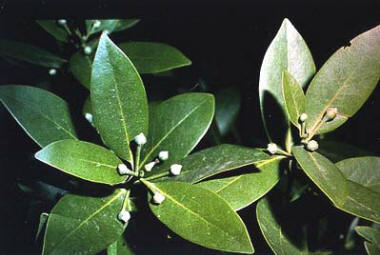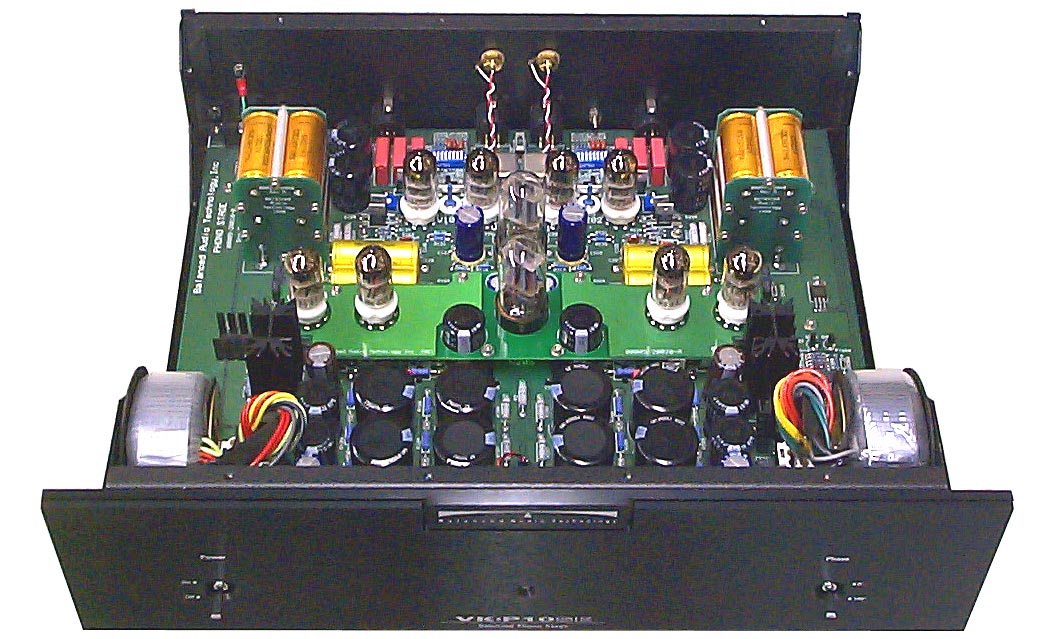|
You are reading the older HTML site
Positive Feedback
ISSUE
23
Dr. Sardonicus and the Pantheistic Journey - The Cardas Heart MC cartridge, BAT VK-P10SE phono preamplifier, and some initial thoughts... People say that the Myrtlewood (umbellularia californica) {Family: Lauraceae (Laurel)} grows exclusively in Oregon. They are wrong. It has a nearly identical cousin, valued even in Biblical times (and residing in the "Holy Land," which is either Las Vegas, or Palestine, depending upon your spiritual convictions), and our version also is native to northern California. See how them state lines become artificial, unless it's a felony warrant? This remarkable tree is also known as the Pepperwood and Bay Laurel (which I find confusing, because obviously the laurel tree is another creature). Danged trees are like fish. Wow, sometimes I am so profound, like Stevie Nicks, I scare myself to death. "Oregon Myrtlewood is a broadleaf evergreen native to Southwestern Oregon and Northwestern California. The Umpqua River watershed appears to be the northern boundary of it's (sic) native habitat. Although different, Oregon Myrtlewood has a lot of similarities to the Myrtlewood growing in the Holy Land. The Myrtle tree grows 60-120' in the wild. It is very slow growing putting on only 1-12" of growth during each of its first few years. They may take 80-120 years to reach full size. It is often multi trunk but can be kept pruned to a single trunk tree. When growing in the open it tends to have a dense, rounded, 'gumdrop shape'. On a shady hillside it grows much taller and narrower. Myrtlewood tolerates many conditions, but grows best and fastest in deep soil with lots of compost, ample water and full sun.
The leaves are 3-5 inches long, 1 inch wide, pointed at the tip, medium green, glossy on top, and dull light green beneath. The crushed leaves have a powerful aromatic scent which can be used as a sure identification. The leaves are frequently used in cooking as a substitute for True Bay (Lauris nobilis), and are also noted as a flea repellant when freshly crushed (author's question …Do you REALLY want to season your stew with flea repellant?). The Myrtlewood has clusters of small yellow flowers (or umbels) which bloom in late winter and olive like seeds or nuts which usually fall from the trees in the fall. Myrtlewood trees will re-grow from their stump and are also grown from their seeds. The Myrtlewood Gallery in Reedsport (author's note, a small town in western Oregon) is actively planting Myrtlewood trees around the area." Source - http://www.myrtlewoodgallery.com/what_is_myrtlewood.htm
Hey, who knew you would hit on an audio 'zine and learn about silviculture? Even at this late age, I am still reaping the benefits of a liberal arts education. Well, Myrtlewood is a shockingly beautiful American hardwood, and certainly it is very closely associated with Oregon …and George Cardas, who is also shockingly beautiful and closely associated with Oregon, believes it has significant and unique sonic properties that enhance the performance of the already redoubtable Benz Ruby product. And so we have the genesis of the Cardas Heart. Stuffy Details You Need to Know I don't know, but I been told, that when completely run-in the cartridge is supposed to function well at an impedance of 47 k, and also that a lower impedance of 500-1.5 k is an option with hum-prone systems. Output is at 0.38mV. Cardas recommends a tracking force of 1.8-2.0g and recommended loading of 500-47,000ohms. The cartridge is said to prefer medium to high mass tone arms. Jennifer Crock of JENA Labs did my set up, and simply muttered darkly that she selected the rough mid-point on the BAT VK-P10 phono stage adjustment range (she does not like tiny internal DIP switches). The SME-10 tone arm, mounted in a custom plinth-Technics SP-10 direct-drive table and wired with JENA Labs kit makes a nice match up, set up for just a hair under 2 grams tracking force. The BAT VK-P10SE Phono Stage Preamplifier
Steve Bednarski of Balanced Audio Technology explains that the P10 is intended as BAT's "ultimate expression" of the tubed phono stage. The P-10 has been around for quite some time before the SE model, which features the SUPER-PACK™ "depth charge" capacitors option, Vishay resistors and other upgrades from the standard P10. This PACK thing ...this is consistent thread through the BAT product line ...reserves. Who in the world makes a phono stage with more current reserve than a lot of power amplifiers? Whacky.
BUT, and this is a HUGE but ...string a line of BAT pieces together (so as not to form an inadvertent bottle neck with other gear) and you get a veritable FIRE HOSE of headroom, creating this incredible, deep breathing phenomena, an indefatigable juggernaut. Run it balanced, run it together. Run for cover. But I am going to take this balanced thing on, frontal assault. See, BAT has not enjoyed the kind of boutique favor they deserve, despite rave reviews from their customers (just Google them and you will see what I mean). I am convinced that a significant part of this is cosmetics. Even with the much appreciated recent cosmetic updating of the line, it is still hugely Russian utilitarian in execution. I think this is so because they insist on putting what they spend "on the plate" rather than on fancy fascia.
If the boutique brands are nouvelle cuisine, $40 for a pea pod and one shrimp, with painted sauces on your plate, and a demitasse cup of foamed chicken broth, then BAT is one of those venerable eating establishments you find in big cities ...that cook as well as any pretentious fern-bistro, but eschew foo-foo and cosmetic frippery for putting the best ingredients, exquisitely crafted on durable plates big enough to comfortably accommodate its Fred Flintstone-esque portions. It's OK if you drop your glass in a moment of gustatorial glee ...it won't break. And, most importantly, the tables will hold you and your party up, should you decide to dance. Then there is the issue of hooking things up. Repeat after me, it is NOT OK to mix balanced and single-ended pieces. Just stop it. Pick an orientation and stick with it.
I have said this before, but it is worth restating a different way, DOES THE TERM BALANCED IN BALANCED AUDIO TECHNOLOGY SUGGEST ANYTHING TO YOU? And this holds true for any equipment that is designed to be ran in balanced mode, not just BAT. If you have heard BAT pieces married with other equipment and ran in single-ended mode, you have not heard it, period. Ran that way, it mostly goes all dark and flat. If I am so fortunate as to be able to sell a spare organ and keep this phono stage, I will have my table rewired for balanced inputs from the phono cartridge. I did experiment with running the P10SE single-ended into my VK-51SE and it just died down and lost all its magic. Trust me, I am right about this. While the P10 is quite capable of handling low-output MC cartridges, it only required "moderate" adjustment for the Cardas Benz. The Heart and the Soul So, someone MUST have anticipated that!
What I can mostly say about the Cardas/BAT/BAT/BAT (P10, 51SE, 600SE) is that it sounds SO good it will make you want to slap yourself. Once upon a time, when I was drugged or something, I went white water rafting on the Salmon River in Idaho. I will make two summary statements about THAT! First, the sandwiches were tres bien. Secondly, a real class four rapids at high flow will suck your love spuds back up into your stomach fast enough to make an audible pop! We were heading into this stretch of rapids, when an honest-to-God whirlpool-of-death spun open in front of us, and down we went. I dug my feet in, clung on for dear life, and closed my eyes. When the sun came out again, the pilot had been blown out of his seat and had whacked one of the passengers over the eye with an oar splitting his head open. The impact had flung most of the people and all of the contents of our raft into the river. I remained seated, but soiled. Before I could really process what had happened, there we were in this absolutely glass smooth stretch, without so much as a ripple …birds singing. It was surreal, like floating in space. This, my friends, is dynamic range. That is what the Cardas/BAT combination is like (albeit without the bloody head wound). At times when I was plumbing the depths of what this system can do, I almost thought I could see the sides of the modest Piega P-10s blowing in and out, like a cartoon safe when the dynamite goes off inside. Then, the quiet would come; a single voice, a distant horn, the delicacy of blown glass. It has been a trial for me. I have been trying to break all this stuff in, and so I run it a lot, and even when I hide my face as I pass the music room, like Odysseus and the Sirens, I am too often beckoned in on to the rocks of indolence. I can't get anything DONE! The Cardas is a perfect match; uncolored and unflappable. It doesn't matter what music you listen to. This is a world-class transducer quite appropriate for matching with the finest downstream equipment. But even as I drag myself out of my music-addled bliss and try to address each piece of this system with some semblance of individual respect, I am drawn inexorably back down into the whirlpool that is earthly delight. [To be continued…if Odysseus survives those Sirens!]
|


